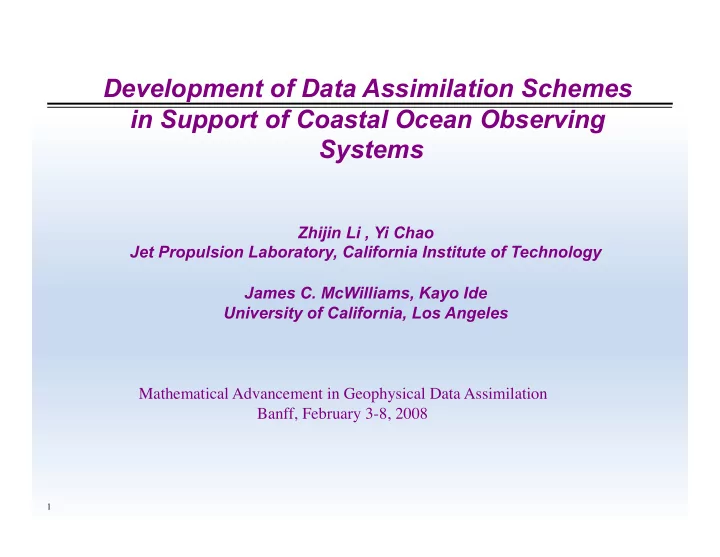

Development of Data Assimilation Schemes in Support of Coastal Ocean Observing Systems Zhijin Li , Yi Chao Jet Propulsion Laboratory, California Institute of Technology James C. McWilliams, Kayo Ide University of California, Los Angeles Mathematical Advancement in Geophysical Data Assimilation Banff, February 3-8, 2008 1
Outline 1. Costal ocean observing systems 2. Assimilated observations 3. Three-dimensional variational data assimilation 4. Evaluation of analyses and forecasts 5. Observing system experiments (OSE) 6. Summary 2
Coastal Oceans 3
Integrated Ocean Observing System (IOOS): data assimilation, forecasting and adaptive sampling Theoretical Users: Understanding & Observations Managers (satellite, in situ) Numerical Education & Models Outreach Data Products Assimilation Information Observing System Design Feedback & Adaptive Sampling 4
Regional Coastal Ocean Observing System (RCOOS) • Sea surface height SSH • Velocity u/v • Temperature T • Salinity S 5
Assimilated Observations: satellite infrared SSTs Microwave, Low resolution (25km) Infrared, High resolution No cloud contamination Cloud contamination NOAA GOES NASA Aqua AMSR-E NASA TRIMM NOAA TMI AVHRR 6
Assimilated observations: satellite SSHs along track JASON-1 ASON-1 Resolution: 120km cross track, 6km along track 7
Real-Time High Frequency Radar Current Short distance: 100km, res of 1km, 5 MHz Long distance: 200km, res of 5km, 25 MHz 8
Assimilated Current Observations Shipboard Buoy Acoustic Doppler Current Profiler (ADCP) Bottom 9
Integrated Ocean Observing Systems * T/S profiles from gliders * Ship CTD profiles * Aircraft SSTs * AUV sections 10
Modeling Approach 15-km 5-km 1.5-km Regional Ocean Modeling System (ROMS): From Global to Regional/Coastal 12-km Multi-scale (or “nested”) ROMS modeling approach is developed in order to simulate the 3D ocean at the spatial scale (e.g., 1.5-km) measured by in situ and remote sensors 11
Model Inputs • Surface wind stress • Precipitation • Heat fluxes • Land water runoff • Topography • Tides (Royer, 2005) 12
Tides Tide Gauge ROMS Simulation HF Radar Obs Sea Surface M2 Tidal Currents 13
ROMS Analysis and Forecast Cycle: Incremental 3DVAR 3-day forecast x f 6-hour forecast 6-hour x a Initial assimilation condition cycle Time Aug.1 Aug.2 Aug.1 Aug.1 Aug.1 14 18Z 00Z 06Z 12Z 00Z
Data Assimilation Formulation Variational methods (3Dvar/4Dvar): prescribed B optimization algorithm Sequential methods (Kalman filter/smoother) dynamically evolved B analytical solution 15
Why a There-Dimensional Variational Data Assimilation • Real-time capability • Implementation with sophisticated and high resolution model configurations • Flexibility to assimilate various observation simultaneously • Development for more advanced scheme 16
Inhomogeneous and anisotropic 3D Global Error Covariance Cross-shore and vertical section salinity correlation SSH correlations Kronecker Product 17
Construction of 3D Corelations with Kronecker Product Kronecker product • Positive definiteness • Cholesky factorization • Computational efficiency (Li et al. 2008) 18
Toward a Relocatable ROMS Forecasting System: Demonstration for Prince William Sound, Alaska 9-km 3-km 1-km 19
Inhomogeneity and Anisotropy 20
Construction of Correlation Matrix C Constructed locally a, b are two locations (e.g., Cummings, 2005) Schur product 21
3DVAR: Weak Geostrophic Constraint Geostrophic balance Geostrophic sea surface level ageostrophic streamfunction and velocity potential 22
Forecast skills: AOSN-II Forecast Correlation " !(+ ,-../0123-4 !(' !(* !(& !() ! "# #$ %& 5-./,1627238/79:;<=> 23
Observing System Experiment (OSE): Glider Data Denial Experiment Temperature RMS Error Salinity w/o CalPoly glider with CalPoly glider SIO CalPoly WHOI 1 st week 2 nd week 24
Impact of HF radar HF Radar ROMS without ROMS with HF radar data HF radar data assimilation assimilation 25
Real-Time SCCOOS Data Assimilation and Forecasting System http://ourocean.jpl.nasa.gov/SCB 26
Observability Model configurations: Grids 280 by 400 Level 40 Averaged decorrelation scale: Horizontal: 20km Vertical: Complex structure Observation availability: HF radar surface currents:10% coverage near shore Glider T/S profiles: several daily Satellite SSTs: cloudless days Ship CDT: survey monthly to seasonally ADCP: survey monthly to seasonally 27
Summary • A coastal ocean observing system requires a data assimilation and forecasting system • Tremendous progresses have been made in observations • A developed data assimilation system has demonstrated forecast skills. • Limited numbers of observations will be a continuing challenge in coming years. • Significant model biases exist 28
Recommend
More recommend